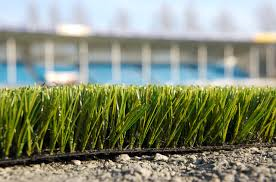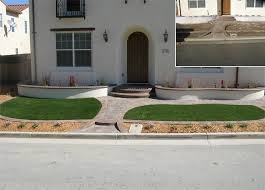

If you have time and money to invest, you will only have to mow, de-thatch, rake, weed, fertilize and remove animal waste from your lawn. The University of California at Davis's Integrated Pest Management website has a lot of information about how to care for your lawn (http://www.ipm.ucdavis.edu/TOOLS/TURF/RENOVATE/index.html).
The tips and techniques found on this site will help you limit, if not preclude, the use of herbicides. By using less herbicide, you limit your exposure, and that of your pets and surrounding plants, to toxic chemicals.
However, the time you spend following these tips is time not spent relaxing on your lawn. I am exhausted thinking about the maintenance required by natural grass. And we can't forget watering. Lawns are, by far, the thirstiest part of a landscape. Over a year, the cost of watering a lawn can be as expensive as a short Hawaiian vacation.
I prefer an annual Hawaiian vacation over a nice lawn. That's why I installed synthetic grass in my yard. After six years, my synthetic lawn looks as great as it did when installed. It hasn't faded from the sun or begun to degrade from the elements. The only maintenance my lawn requires is an occasional pass with a leaf blower to give it a fresh-mowed look.
When it's in direct sun, the synthetic grass can get hot, which is also often the case with natural grass. Most synthetic turf reflects light, reducing the amount of heat it will absorb and limiting fading. You can place patio furniture on a synthetic lawn without damaging the turf. I do use rubber coasters under furniture legs to distribute the weight, but that's just for peace of mind.
With synthetic turf, you don't have to worry about subterranean creatures digging holes, as they do in natural turf. The base fabric is strong enough to prevent animals from digging or chewing through it, while still porous enough that water will drain through.
The product has come a long way since it was first introduced in 1965 in the new Houston Astrodome and given the moniker “Astroturf.” There are numerous brands, with a choice of colors and pile height. Golfers can even have a putting green installed.
To provide the cushioned feel of natural grass, synthetic grass has a fill of either sand, fractured rubber or a combination. This fill keeps the grass upright, prevents matting and serves as an excellent weed barrier.
Proper installation of a synthetic lawn requires more than just cutting, measuring and unrolling. Installation should be performed by a licensed landscape contractor who is proficient with the product. A conscientious contractor will prepare the site by excavating several inches below the level of the lawn and backfilling with compacted drainage rock so that water will filter through the lawn and not pool on top.
Some people question whether synthetic grass is safe for children and pets. Concerns include possibly high levels of lead. The Centers for Disease Control and Prevention studied synthetic playing fields in New Jersey for risk of lead exposure (http://www.cdc.gov/nceh/lead/tips/artificialturf.htm). The study determined that lawns made of nylon or a nylon-polyethylene blend carry a potential health risk, while lawns made entirely of polyethylene contain a low level of lead.
When shopping for a synthetic lawn, ask about the composition. However, a typical home lawn is probably too small to carry much risk of exposure. Synthetic grass may be less flammable than natural turf, but conclusive research is hard to find. Common sense suggests that the turf would melt or at least scorch if exposed to fire, a hazard even if the grass doesn't ignite. Protect your artificial turf from open flame and extreme heat.
With some research, many homeowners will decide that synthetic grass is an economical and environmentally friendly alternative to a natural lawn. Making the change will free up time to spend enjoying the yard.
Tomato Sale and Education Event: Napa County Master Gardeners are hosting their third annual Tomato Sale on Saturday, April 18. Join us in the South Oxbow parking lot in Napa, 9 a.m. until sold out. We have a bountiful selection of strong, young plants: heirlooms, hybrids, cherry, paste and just plain good eating tomatoes of all sizes. Remember to bring your own box to safely transport your plants home. Click on the link above to read descriptions of the varieties for sale.
Master Gardeners are volunteers who help the University of California reach the gardening public with home gardening information. Napa County Master Gardeners ( http://ucanr.org/ucmgnapa/) are available to answer gardening questions in person or by phone, Monday, Wednesday and Friday, 9 a.m. to Noon, at the U. C. Cooperative Extension office, 1710 Soscol Avenue, Suite 4, Napa, 707-253-4143, or from outside City of Napa toll-free at 877-279-3065. Or e-mail your garden questions by following the guidelines on our web site. Click on Napa, then on Have Garden Questions? Find us on Facebook under UC Master Gardeners of Napa County.